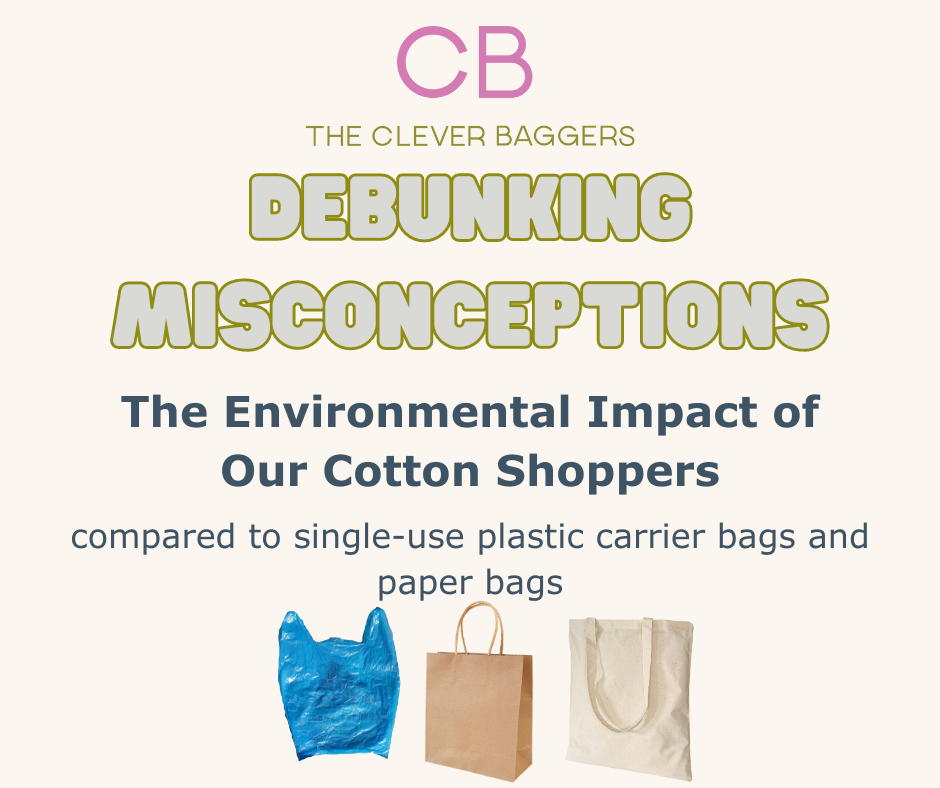Browse our latest Clever News!
There's always something going on that we can talk about.
Whether you need tips on print techniques and artwork specifications,
inspiration for your next project, or just want to read about the war on
single-use plastic, we've got you covered. But if you're just here to be
nosey about what we're up to, that's ok too. We won't judge.
Come have a browse of our latest Clever News!
Browse our latest Clever News,
There's always something going on!
Get tips on print techniques and
artwork specifications, inspiration
for your next project, or learn about
the war on single-use plastic,
read here!
Debunking Misconceptions: The Environmental Impact of our Cotton Shoppers.
Posted on: 26/04/2024, 07:30
As a predominantly cotton tote bag business, we have dealt with misinformation for years about how cotton is processed as “worse for the environment” than single-use plastic or, more recently, paper bags. We are going to delve into this deeper, as many studies will only paint you half the picture. We’ve broken things down into the different stages of the product life cycle so if you’re more interested in comparing the effect of disposal than manufacture then you can easily find the relevant section.

First: Sourcing and manufacture
Single-Use Plastic – Is made from polyethylene which is derived either from refined oil or cracked natural gas. These are found mostly underground and our mainly reached through drilling wells, disrupting the local ecosystem and can present disastrous consequences for human and environmental health if leaks occur. The oil or gas is then super-heated (that’s a lot of energy!) and pressurised to create pellets of pure plastic. The Plastic pellets are then superheated and pressurised again to form a liquid bubble. After it’s cooled it is stretched through machine rollers to form thin sheets that will make the walls of the bag, then it is sent to the printing machine., Some of the dyes used can be toxic and threaten marine organisms, but there are safer alcohol-based inks that can be used instead.
Information regarding single-use plastic carrier bag creation has been taken from this website: How Are Plastic Bags Made? | Greentumble
Paper Bags – Have been around since the late 1800s. While they have been promoted as an environmentally friendly alternative to plastic carriers, they do require a considerable amount of water and energy to produce. Paper bags are constructed from tree bark, which is turned into a pulp and then formed into paper sheets, with colour added at this stage using dyes. Paper Bags are made on a large machine, the machine requires 1 gallon of water per paper bag as well as the burning of fossil fuels to produce. The tree pulp comes from trees that have been dried for at least three years. Let’s not forget that even though paper bags are made from trees, we are still cutting these trees down to create these paper bags, causing deforestation and subsequent ecosystem damage including loss of natural carbon storage for which vast quantities of formerly productive farmland have been transformed into forests in recent years as multinational companies race to offset their carbon emissions. Even with careful forest management the clear felling method of harvesting favoured in Europe and many other parts of the world can cause massive loss of wildlife habit within a matter of hours.
Information regarding paper bag creation has been taken from this website: What Are Paper Bags Made Out Of? | ehow
Cotton Shoppers – The biggest argument you will hear against cotton shoppers is how their ’environmental impact extends beyond their lifecycle’. Cotton is a plant, with the fibres from which cotton cloth is made being harvested from the ‘boll’ which protects the cotton seeds as they mature. It takes approximately one year from the sowing of a cotton seed into the earth to the production of a finished cotton bag. What do these cotton plants require for growth to make them so environmentally impactful? Soil, warmth, sunlight and water. Yep, very harmful for the environment, all these natural things. A more thorough insight to this can be found below.
What does a Cotton Plant Need to Grow?
-
Climate and Temperature – this includes a long frost-free period, a soil temperature higher than 15°C for a successful germination, an active growth temperature ranging from 21°C – 27°C, and the cotton plant thrives in warm and humid climates with plenty of sunshine. This is the main reason we are unable to produce successful cotton crops in the UK.
-
Sunlight – cotton needs full sun to be productive.
-
Water –cotton is a thirsty plant and does require plenty of rainfall, it requires consistent moisture during its growth stages. This is why it is grown in tropical and sub-tropical regions only, where natural rainfall patterns are ideal for the plants’ growth cycle.
Like many other plants, the cotton plant does need attention and the best care. Cotton crops face threats like weeds, pests, and diseases. These are monitored by farmers and modern preferences are for the use of natural repellents, rather than harsh chemicals.
Following on from how cotton is grown, the fibres are spun into yarn, which is woven into cloth, which is then cut and stitched to make your cotton shopper bag. In modern factories these processes are powered by electricity, with manufacturers moving increasingly towards renewable energy sources and away from fossil fuels. With the aid of government grants as well as forward-thinking management, many manufacturers across the world are installing wind turbines and solar panels on site to power their machinery.
At The Clever Baggers we purchase our products from carefully chosen suppliers in China, India, and Europe. We do not dictate the price we pay for these products; we accept prices offered so long as they are commercially viable. We have devoted a lot of time to this issue, to ensure the products we buy have been produced in an environmentally and ethically sound manner.
Information regarding cotton bag creation has been taken from the following websites: , Cotton production by country worldwide 2022/2023 | Statista , Cotton Production by Country 2024 (worldpopulationreview.com) , https://www.thecleverbaggers.co.uk/sustainablity-information
Second: How These Products Are Transported
Single-Use Plastic Carrier – Fortunately, plastic and single-use plastic carrier bags can be made in the UK and Europe, minimising their transportation needs. This can be seen as good for the environment, especially with the introduction of greener transportation options such as electric vehicles.
Paper Bags – Paper bags can also be manufactured in the UK and Europe, reducing their need for further transportation.
Cotton Shopper Bags – As mentioned previously, cotton is not indigenous to the UK, so we do have to source our products from overseas. Due to this we take positive steps towards minimising the environmental impact of transportation. We use sea freight to transport ready-made products in containers of 100,000+ units at a time, which on average lowers the carbon footprint of each item. Our massive stock is all held on site in the UK to minimise the number of deliveries received throughout the year. Because we keep on top of our supply, we can eliminate the need for air freight, even when a quick turnaround is needed. Although the carbon footprint caused by transportation is rather large, we have yet to find an alternative which is lower. We believe our process is as environmentally friendly as it can be – but we always look for ways to improve it.
Third: Usage
Single-Use Plastic Carrier Bags – It’s in the name here, it’s single-use. I’ll be honest here, you probably will get a second use out of it before you need to dispose of it, and that is usually to be used as a rubbish bag.
Paper Bags – It’s stated in the Danish Study from 2018 that you would need to reuse a paper bag 43 times to cover the environmental impact that their production and transportation has caused. I don’t know about you, but I don’t think I could manage 43 uses of every single paper bag I’ve been handed in a shop, cafe, or at an event. They’re easy to tear, and if you get that baby wet, it won’t turn into a Gremlin, but it will disintegrate and become unusable. A few weeks back, I was walking home from a coffee shop with my treats in a paper bag when it started hammering it down with rain. Myself, the dog, and the contents of the bag were soaked, the bag was damp and instantly went into the recycling, so I barely got one use out of it.
Cotton Shopper Bags – The same Danish Study from 2018 stated that you would have to use a cotton shopper bag 7000 times to cover the environmental impact that their production and transportation has caused. That works out at just over 19 years. We have seen and heard many people have been using their cotton shopper bags longer than this, some for over 20 years! Cotton bags are created to last and be used again and again, with different uses, like using as an everyday bag, holding shopping, and even used as storage bags. Recently we have seen people on social media use their many cotton tote bags to create unique items of clothing like dresses, skirts and jackets, which we think is a fantastic and creative use for cotton shopper bags, especially if you have a variety of prints that can create such a unique garment.
Fourth: Disposal
Single-Use Plastic Carrier Bags - As we all know and have been told, single-use plastic carrier bags take 1000 years to decompose. However, this is quite misleading, as even when the bag disintegrates, they leave behind tiny micro plastics that continue to harm the environment. Good news though, if your single-use plastic carrier bag has a 2 or 4 symbol on them you can recycle them, by taking them usually to your nearest supermarket to be recycled. But be aware that recycling them will also increase their environmental impact as the bag will need to be transported, produced into the new product, and then transported again.
Paper Bags – Luckily this can be placed in your at home recycling and recycled into something else. However, that does mean more energy is used for more production and transportation to “recycle” this product into something new. So, when you consider that, it will impact the environment more. You can also add this to your home compost, which would reduce the environmental impact the paper bag is causing.
Cotton Shopper Bags – “recycling was not considered for this type of bag, if you recycled this bag, it would lower the impact of using a cotton bag” – Danish Study 2018. In terms of disposal, cotton is a natural product, so that means when it has fulfilled its purpose, it can be shredded and placed in a domestic composting bin or taken to an household recycling centre or industrial composting facility where it will provide the necessary carbon elements to the compost mixture.
You can also recycle your tote bags by sending them to a textile recycling facility.
“Textile recycling and sustainability experts said that even if cotton totes are sent to be recycled, logos and messages printed on the bags are not recyclable and have to be cut out of the cloth, wasting an estimated 10 to 15 per cent of cotton received by a single recycling firm.” – The Independent 2021.
Well, I can only speak for The Clever Baggers here, but we have invested in our machinery over the years to ensure our print processes are also sustainable. We use water-based inks for all our printing for that reason. We mix our ink by hand and recycle colours to create new colours to minimise our waste.
Conclusion
While all three types of bag mentioned in this blog post have their positives and negatives, it is interesting to note the differences in their environmental impact due to methods of production, transportation, and disposal - and in most cases, often not spoken about, the environmental impacts of recycling these types of bags.
It’s interesting to note that the 2018 Danish Study funded by the Environmental Department, which is often used as a reference when discussing these issues, was tasked to specifically look at bag usage and suitability for supermarkets. The study therefore does not take into account using any of the types of bags in other everyday uses, or even as a promotional item.
If you are a brand or business, you are going to want to purchase a product for promotional use with longevity. Out of the three detailed in this blog, which are you going to choose? The Single-Use Plastic Carrier Bag that gets used as a bin liner after one use? The Paper Bag, that - lets be honest here - doesn’t get used again and ends up straight in the recycling? Or the “Environmentally Impactful” Cotton Shopper Bag that will be used for years and years as practically a walking billboard for your brand? Yeah we thought so.
Danish Study funded by the Environmental Department Rapport (mst.dk)







